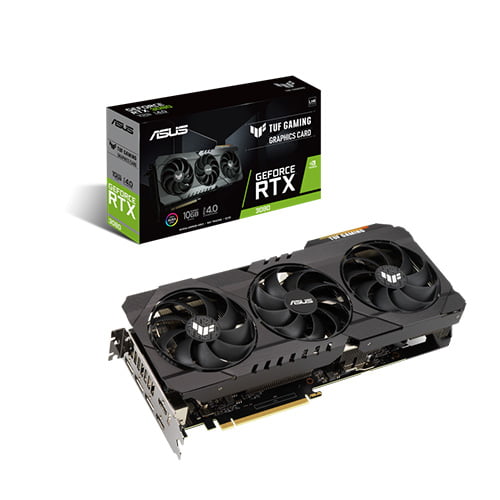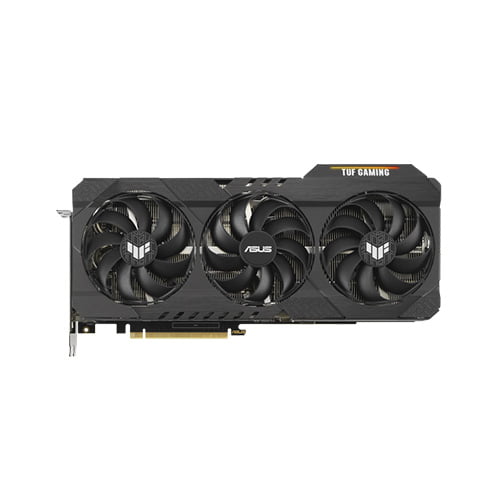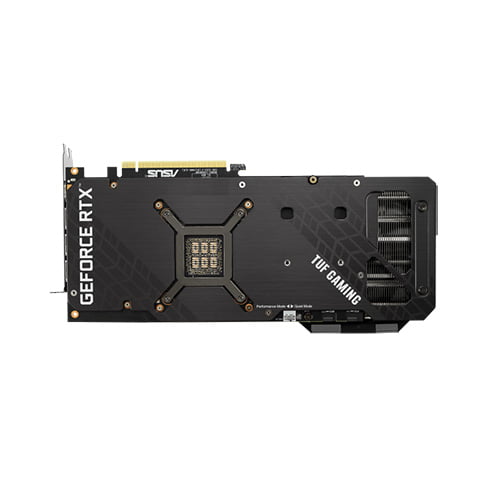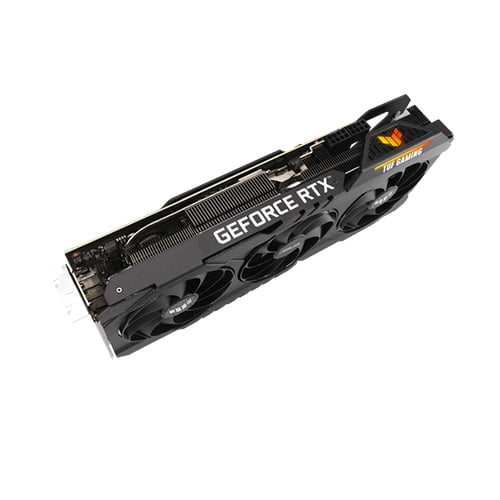| Summary |
Asus TUF GeForce RTX 3080 V2 Graphics Card
Asus TUF GeForce RTX 3080 V2 Graphics Card has been stripped down and built back up to provide more robust power and cooling. A new all-metal shroud houses three powerful axial-tech fans that utilize durable dual ball fan bearings. Fan rotation has been optimized for reduced turbulence, and a stop mode brings all three fans to a halt at low temps. Beneath, independent heatsinks for the GPU and memory keep thermals under tight control. Additional features, including TUF components, Auto-Extreme Technology, a new GPU bracket, and a backplate vent make the TUF a proper powerhouse. TUF Gaming cards leverage our tried-and-true Axial-tech fan design, with three fans working in tandem to satisfy the thermal demands of NVIDIA's new high-octane design. The fans rely on dual ball fan bearings to ensure consistent performance and increased longevity compared to sleeve bearings and other bearing types. To get heat into the heatsink array efficiently, so that it can be whisked away by the powerful axial-tech fans, we use a manufacturing process that improves the surface smoothness of the heat spreader at the microscopic level.
Asus TUF GeForce RTX 3080 V2 Graphics Card extra flatness allows for better contact with the die for improved thermal transfer. The heat spreader draws heat up into heat pipes that carry it through a fin stack that fills most of the card's large, 2.7-slot footprint. This generation of TUF Gaming graphics cards also features a dedicated heatsink for VRAM to keep temperatures well under the maximum. The underside of the card reveals a host of improvements. Most of the rear is swathed in a protective metal backplate that prominently features a wide vent. The vent allows hot air to escape towards chassis exhaust fans instead of being recycled back into the GPU cooler. Beneath the GPU, a bracket provides consistent mounting pressure between the die and the heat spreader. ASUS GPU Tweak II utility takes graphics card tuning to the next level. It allows you to tweak critical parameters including GPU core clocks, memory frequency, and voltage settings, with the option to monitor everything in real-time through a customizable on-screen display... |
ZOTAC GAMING RTX 3080 AMP Extreme Holo LHR Graphics Card
ZOTAC GAMING RTX 3080 AMP Extreme Holo LHR Graphics Card based on the NVIDIA Ampere architecture is here with the AMP Extreme Holo. Built with enhanced RT Cores and Tensor Cores, new streaming multiprocessors, and superfast GDDR6X memory, the GeForce RTX 3080 AMP Extreme Holo 12GB gives rise to the absolute gaming experience with ultra graphics fidelity.
Features:
- 12GB GDDR6X memory
- HoloBlack Design
- SPECTRA 2.0 RGB Lighting (compatible with external LED strip)
- IceStorm 2.0 Advanced Cooling
- Advanced Cooling with FREEZE Fan Stop
- PowerBoost
- Dual BIOS
- Metal RGB LED Backplate
- FireStorm Utility (Download HERE)
- 2nd Gen Ray Tracing Cores
- 3rd Gen Tensor Cores
- VR Ready
- LHR 52 MH/s ETH hash rate (est.)
[ninja_tables id="57046"].. |
Nvidia RTX A4000 Ampere Architecture 16GB GDDR6 Graphics CardThe Nvidia RTX A4000 is a professional-grade graphics card based on the Ampere architecture, designed for use in high-performance workstations. It comes equipped with 16GB of GDDR6 memory, which is a high-speed type of memory that enables faster data transfer rates and improved performance. The RTX A4000 utilizes the PCIe 4.0 interface, which is the latest and fastest interface for connecting a graphics card to a workstation's motherboard. It is specifically designed for professional applications such as architecture, engineering, and design, where high-performance graphics are essential for efficient and effective work. The card supports multiple displays and has a maximum resolution of 7680x4320 at 60Hz, making it suitable for working with high-resolution displays. The RTX A4000 also supports the latest graphics APIs, such as DirectX 12 Ultimate and Vulkan 1.2, providing access to cutting-edge technologies for rendering and visual effects. One of the most significant features of the RTX A4000 is its use of Nvidia's RT cores and Tensor cores. These specialized processing units enable real-time ray tracing and AI-accelerated workflows, providing faster and more accurate rendering and simulations. Additionally, the card includes other features, such as Variable Rate Shading (VRS), Mesh Shading, and Multi-View Rendering, that further enhance performance and visual fidelity in professional applications.Overall, the Nvidia RTX A4000 Ampere Architecture 16GB GDDR6 Graphics Card is a powerful and reliable option for professional-grade workstations. Its high-performance memory, latest PCIe interface, support for high-resolution displays, and cutting-edge processing units make it a top choice for demanding professional applications.FeaturesThe Nvidia RTX A4000 Ampere Architecture 16GB GDDR6 Graphics Card is packed with features that make it a top-of-the-line professional-grade graphics card for workstations. Some of its key features include:16GB GDDR6 Memory: The RTX A4000 comes with 16GB of high-speed GDDR6 memory that provides faster data transfer rates and improved performance for demanding professional applications.PCIe 4.0 Interface: The card utilizes the latest PCIe 4.0 interface, which provides faster bandwidth and improved performance for data transfer between the graphics card and the workstation's motherboard.Real-time Ray Tracing and AI-Accelerated Workflows: The card includes specialized processing units, called RT cores and Tensor cores, that enable real-time ray tracing and AI-accelerated workflows. This results in faster and more accurate rendering and simulations for professional applications.Support for High-Resolution Displays: The card supports multiple displays and has a maximum resolution of 7680x4320 at 60Hz, making it suitable for working with high-resolution displays.Cutting-edge Graphics APIs: The RTX A4000 supports the latest graphics APIs, including DirectX 12 Ultimate and Vulkan 1.2, providing access to cutting-edge technologies for rendering and visual effects.Variable Rate Shading (VRS), Mesh Shading, and Multi-View Rendering: These features further enhance performance and visual fidelity in professional applications.Energy Efficient: The card has a low power consumption, making it energy-efficient for long-term use in workstations.Overall, the Nvidia RTX A4000 Ampere Architecture 16GB GDDR6 Graphics Card is a powerhouse of a graphics card with cutting-edge features that make it a top choice for demanding professional applications. Its high-performance memory, latest PCIe interface, support for high-resolution displays, and specialized processing units make it ideal for use in architecture, engineering, and design applications, as well as other industries that require high-performance graphics... |
ASUS TUF Gaming GeForce RTX 4070 Ti 12GB GDDR6X Graphics CardThe ASUS TUF Gaming GeForce RTX 4070 Ti 12GB GDDR6X Graphics Card represents the pinnacle of gaming performance, engineered to deliver unparalleled visuals and seamless gameplay experiences. Powered by the formidable NVIDIA® GeForce RTX™ 4070 Ti graphic engine, this graphics card sets a new standard for high-end gaming. Featuring a robust GDDR6X memory with a generous 12GB capacity, coupled with a 192-bit memory interface and a blistering memory clock speed of 21 Gbps, the ASUS TUF Gaming RTX 4070 Ti ensures lightning-fast data processing and smooth rendering of even the most demanding gaming environments. The card boasts an impressive array of connectivity options, including 2x native HDMI 2.1 ports and 3x native DisplayPort 1.4a ports, enabling seamless integration with the latest high-resolution displays and immersive VR setups. With support for resolutions up to an astonishing 7680 x 4320, every detail is rendered with breathtaking clarity and precision. Equipped with 7680 CUDA cores and powered by PCI Express 4.0 technology, the ASUS TUF Gaming RTX 4070 Ti delivers unprecedented levels of performance, allowing for silky-smooth frame rates and responsive gameplay across a wide range of titles. Whether you're exploring vast open worlds, engaging in intense multiplayer battles, or diving into immersive VR experiences, this graphics card ensures an uncompromising gaming experience. Designed with durability and reliability in mind, the ASUS TUF Gaming RTX 4070 Ti features a sturdy construction and comes bundled with a range of accessories, including a TUF Graphics Card Holder and TUF Velcro Hook & Loop for easy installation and maintenance. Additionally, ASUS provides comprehensive software support through ASUS GPU Tweak III, ensuring easy customization and optimization of your gaming experience. Combined with regular updates through GeForce Game Ready and Studio Drivers, you can rest assured that your system is always primed for peak performance. Backed by a 3-year warranty, the ASUS TUF Gaming GeForce RTX 4070 Ti 12GB GDDR6X Graphics Card offers both performance and peace of mind, making it the ideal choice for discerning gamers seeking the ultimate gaming experience.Features:NVIDIA GeForce RTX 4070 Ti GPU: The graphics card is powered by the high-performance NVIDIA GeForce RTX 4070 Ti GPU, delivering exceptional gaming experiences with cutting-edge ray tracing, AI-enhanced graphics, and real-time rendering capabilities.12GB GDDR6X Video Memory: Equipped with a generous 12GB of GDDR6X video memory, the graphics card ensures smooth performance and efficient data processing for handling graphically demanding tasks and games.PCI Express 4.0 Interface: With support for the latest PCI Express 4.0 interface, the ASUS TUF Gaming RTX 4070 Ti offers increased bandwidth and faster data transfer speeds, maximizing the performance potential of modern gaming systems.Native HDMI 2.1 and DisplayPort 1.4a Connectivity: Featuring 2x native HDMI 2.1 ports and 3x native DisplayPort 1.4a ports, the graphics card provides versatile connectivity options for high-resolution displays, VR headsets, and multi-monitor setups.7680 CUDA Cores: The graphics card is equipped with 7680 CUDA cores, enabling parallel processing for accelerated rendering, AI tasks, and compute-intensive workloads, resulting in smoother gameplay and faster performance.ASUS TUF Gaming Design: Built to withstand the rigors of gaming, the ASUS TUF Gaming RTX 4070 Ti features a durable design with military-grade components, ensuring reliability and longevity even under demanding gaming conditions.Advanced Cooling Solution: The graphics card incorporates an advanced cooling solution with multiple fans and heat pipes, effectively dissipating heat to maintain optimal operating temperatures during intense gaming sessions.Support for 4K and 8K Resolutions: With support for resolutions up to 7680 x 4320, the graphics card delivers stunning visual fidelity and immersive gaming experiences, allowing users to enjoy games, movies, and content in ultra-high definition.ASUS GPU Tweak III Software: ASUS GPU Tweak III software provides intuitive tools for overclocking, monitoring, and optimizing the performance of the graphics card, allowing users to tailor their gaming experience to their preferences.Comprehensive Warranty: Backed by a 3-year warranty, the ASUS TUF Gaming GeForce RTX 4070 Ti offers peace of mind and assurance of quality, ensuring reliable performance and support for years to come... |





















